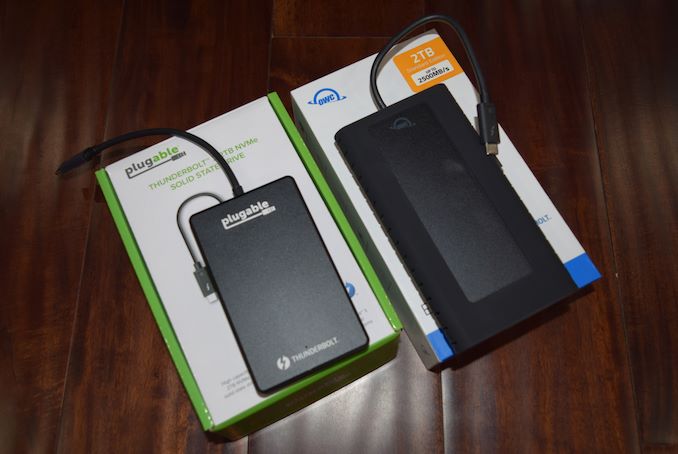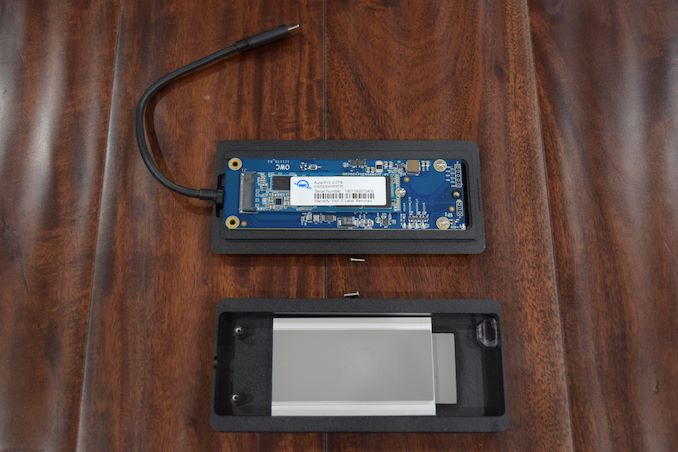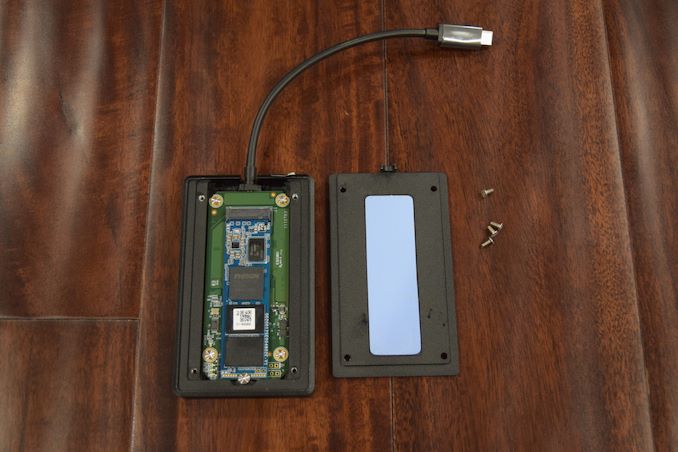
Original Link: https://www.anandtech.com/show/15091/owc-envoy-pro-ex-thunderbolt-3-and-plugable-tbt3nvme2tb-portable-ssds-review
OWC Envoy Pro EX Thunderbolt 3 and Plugable TBT3-NVME2TB Portable SSDs Review
by Ganesh T S on November 12, 2019 9:00 AM EST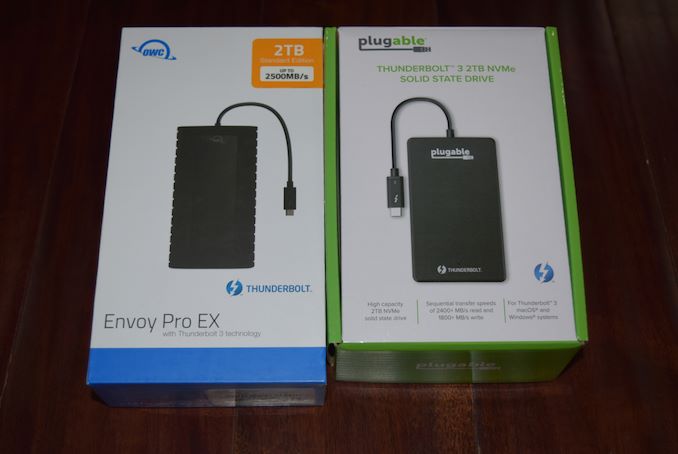
Portable SSDs with NVMe-based internal drives and a Thunderbolt 3 interface are the fastest bus-powered storage devices currently available in the market. We have been following this market since it moved beyond the niche category with a steady review of incoming products, while also experimenting with DIY models. The recent glut in the flash market with low-priced, yet high-performance, 3D TLC memory and the availability of Phison's Thunderbolt 3 external SSD reference model has enabled vendors to put out relatively cheap high-capacity Thunderbolt 3 SSDs. This review investigates the performance and features of two 2TB Thunderbolt 3 SSDs that do not break the bank - the OWC Envoy Pro EX Thunderbolt 3 (Standard Edition) and the recently launched Plugable TBT3-NVME2TB.
Introduction and Product Impressions
The OWC Envoy Pro EX Thunderbolt 3 and the Plugable TBT3-NVME2TB are both high-performance PCIe 3.0 x4 NVMe SSDs in a aluminium enclosure. While the OWC drive comes with a protective impact-tolerant bumper for ruggedness and MIL-STD810G certification, the Plugable drive has a slimmer form-factor. Both SSDs come with an integrated Thunderbolt 3 cable, with an Intel Alpine Ridge controller on board. It must be kept in mind that these drives work only with Thunderbolt 3 Type-C ports.
On the other side of the Alpine Ridge is a PCIe 3.0 x4 connection that leads to a M.2 slot capable of accommodating M.2 2260 or 2280 PCIe SSDs. In the OWC Envoy Pro EX, the slot is occupied by a OWC Aura P12 NVMe SSD sporting a Phison E12 SSD controller and 3D TLC memory.
In the case of the Plugable unit, we have an unmarked Phison E12-based NVMe SSD, again with 3D TLC NAND.
We recently updated our DAS testbed to Windows 10 v1809, and one of the important changes is the alteration in the default policy for external drives. Earlier versions used to enable write caching by default, while making it necessary to safely eject the drive from the taskbar. The new default policy is set to disable write caching, while allowing for easy removal.
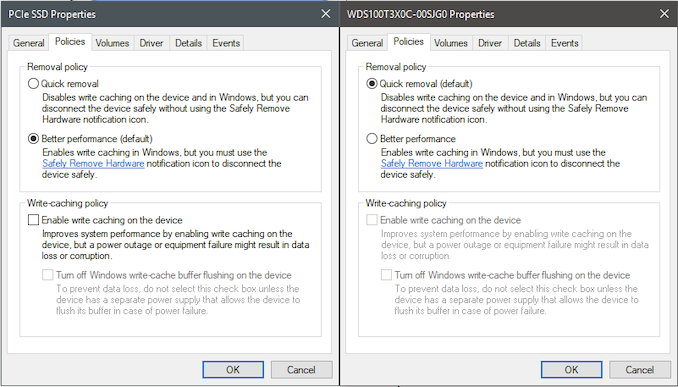
External Device Policy in Windows 10 (v1803 and Prior (L), v1809 and Later (R))
We endeavor to benchmark external drives in the default state as much as possible, and the nett result is that we will be comparing the OWC and Plugable drives today only against one other Thunderbolt 3 SSD from our previously reviewed set. We were able to benchmark our DIY Thunderbolt 3 SSD using the TEKQ Rapide and the Western Digital Black SN750 NVMe SSD using the updated testbed, and the new numbers can be seen in the rest of the review.
We start off the review with some insights into the internal drives provided by CrystalDiskInfo.
| Drive Information |
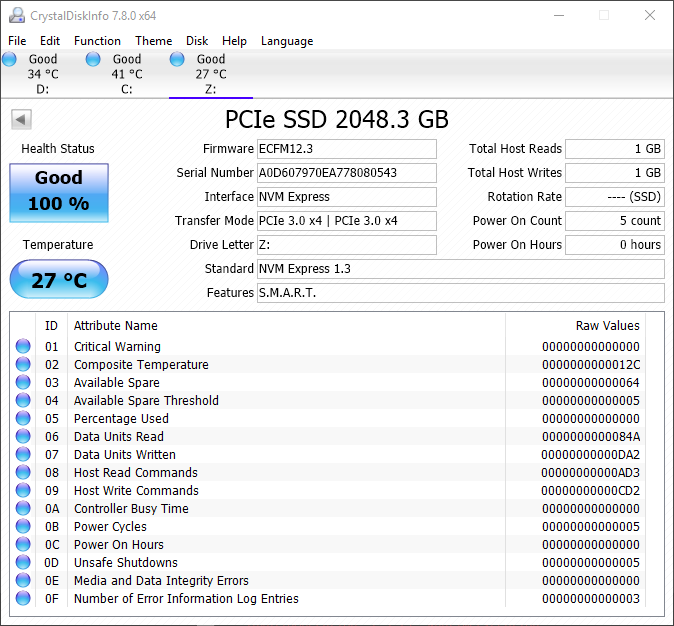 |
Even though CrystalDiskInfo puts only SMART in the features section, we did see support for TRIM. The Thunderbolt link is essentially invisible to the tool, with NVM Express listed as the interface. For all practical purposes, both devices appear to the system as PCIe 3.0 x4 NVMe SSD. The other aspect of interest (given the use of the Phison E12 in the new SSDs being considered today) is that the Plugable drive uses a more recent firmware version compared to the OWC Envoy Pro EX Thunderbolt 3.
Synthetic Benchmarks
Various synthetic benchmarks are available to quickly evaluate the performance of direct-attached storage devices. Real-world performance testing often has to be a customized test. We present both varieties in this review, starting with the synthetic benchmarks in this section. All benchmarks were processed with the drive formatted in NTFS, even though the Plugable TBT3-NVME2TB comes pre-formatted in exFAT. Prior to covering the performance benchmarks, a quick note on our testbed - The Thunderbolt 3 host used for performance measurement across all considered devices today is enabled by the Alpine Ridge controller in the Hades Canyon NUC. The list of DAS units used for comparison purposes is provided below:
- Plugable TBT3-NVME2TB 2TB
- OWC Envoy Pro EX Thunderbolt 3 2TB
- DIY TEKQ Rapide - WD Black SN750 TB3 SSD 1TB (Win 10 1809)
ATTO and Crystal DiskMark
OWC claims reads of up to 2500 MBps, while Plugable claims read and write speeds of 2400 MBps+ and 1800 MBps+. The write speed is with write caching enabled in Windows, which we did not opt to test with. The read speed claims are backed up by the ATTO benchmarks provided below. Unfortunately, these access traces are not very common in real-life scenarios. That said, it is interesting to see that the WD Black in the TEKQ Rapide is able to sustain 2000 MBps+ on the writes despite the default disabling of write caching in the OS.
| Drive Performance Benchmarks - CrystalDiskMark |
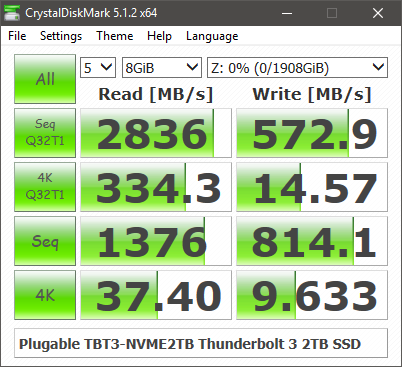 |
For relatively small writes and reads (within the SLC cache size, such as the 8GB access span for the CrystalDiskMark workloads above), the DIY SSD with the WD Black SN750 easily emerges as the top performer. Between the Plugable and the OWC drives, we see reads performing very similarly. The writes show a slight edge for the Plugable drive, probably due to the additional firmware tuning.
Real-World Benchmarks and Performance Consistency
Our testing methodology for DAS units also takes into consideration the usual use-case for such devices. The most common usage scenario is transfer of large amounts of photos and videos to and from the unit. The minor usage scenario is importing files directly off the DAS into a multimedia editing program such as Adobe Photoshop.
In order to tackle the first use-case, we created three test folders with the following characteristics:
- Photos: 15.6 GB collection of 4320 photos (RAW as well as JPEGs) in 61 sub-folders
- Videos: 16.1 GB collection of 244 videos (MP4 as well as MOVs) in 6 sub-folders
- BR: 10.7 GB Blu-ray folder structure of the IDT Benchmark Blu-ray (the same that we use in our robocopy tests for NAS systems)
| Performance Consistency and Thermal Characteristics |
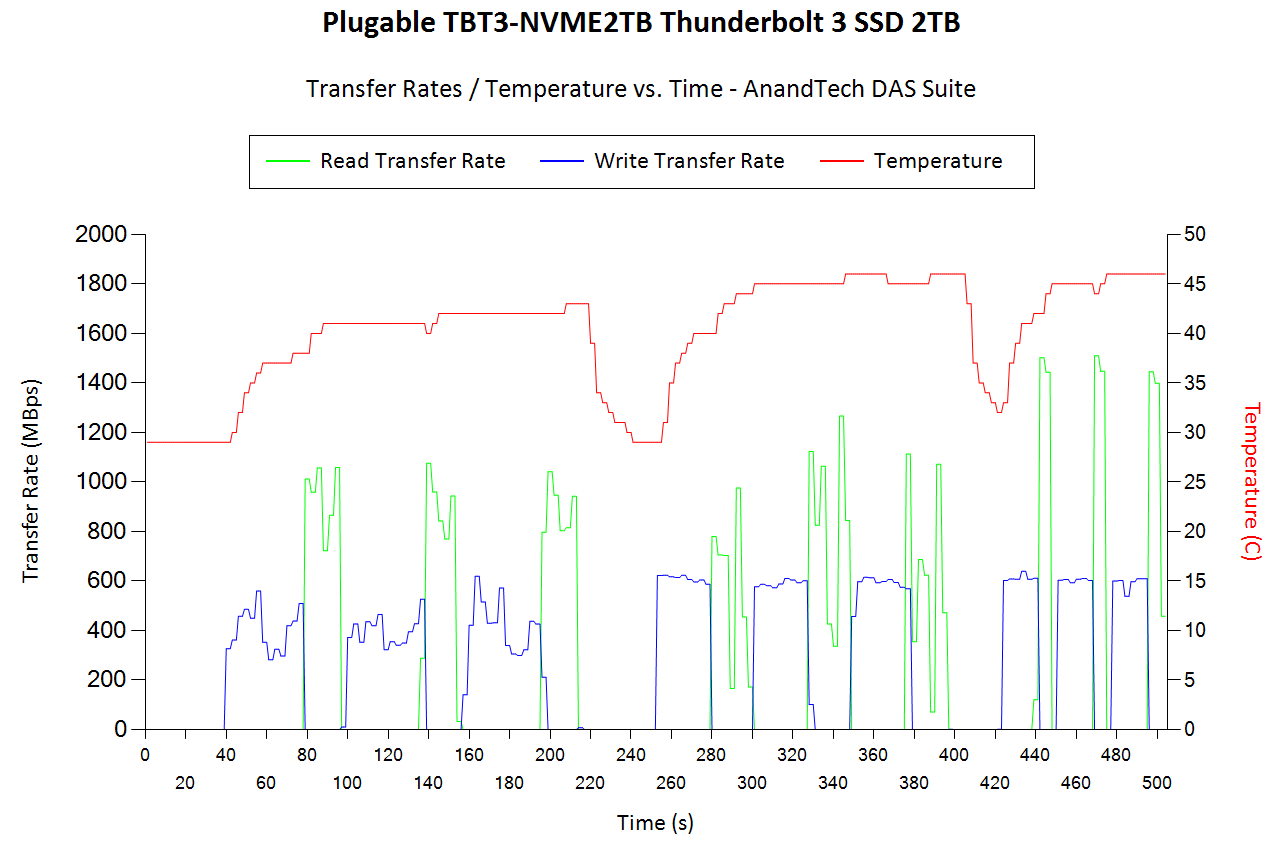 |
The temperature profiles across the three drives in the above graphs show that the Plugable drive is the quickest of the lot to cool down. It is likely that the OWC drive's bumper has some detrimental effect on the cooling prowess, but the drive is still kept well within thermal limits for reasonable use-cases such as the above consistency test.
Miscellaneous Aspects and Concluding Remarks
The performance consistency for real-world applications was looked at in the previous section. We recently added a test to determine the effectiveness of the thermal solution for sustained workloads. After deleting the SSD volume, a fio workload was set up to write sequential data to the raw drive with a block size of 128K and iodepth of 32 to cover 90% of the drive capacity. The internal temperature, instantaneous write data rate, and total amount of data written in total till that point of time were recorded.
| TRIM Support |
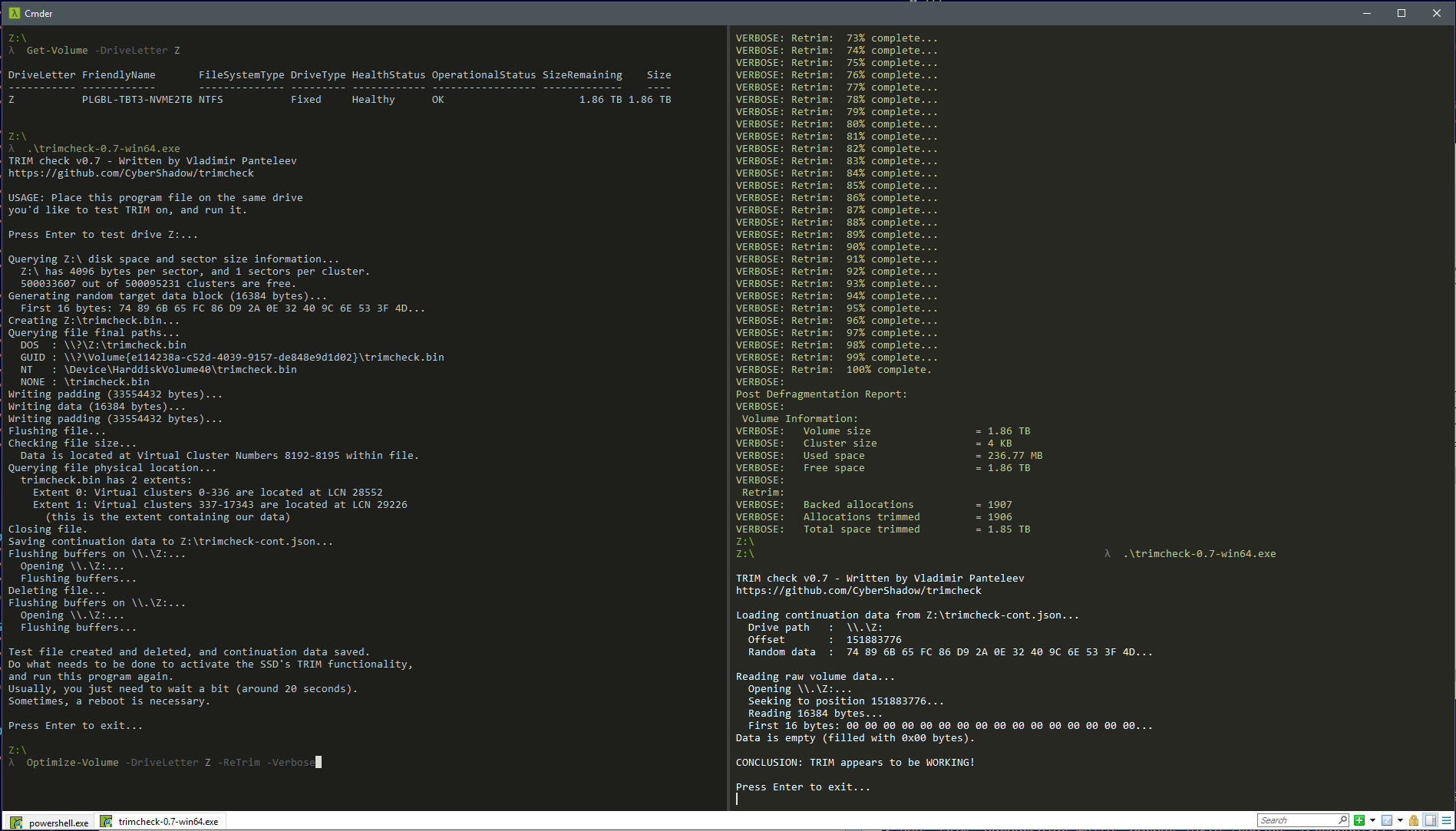 |
Moving on to the pricing aspect, Plugable is launching the TBT3-NVME2TB at $500, but, with a $100 discount on top. Even with a $500 price tag, the TBT3-NVME2TB is the most economical of the lot on a per-GB basis. Its post-formatted 2048 GB capacity gives it the edge, when compared with the 1920GB capacity of the OWC Envoy Pro EX Thunderbolt 3.
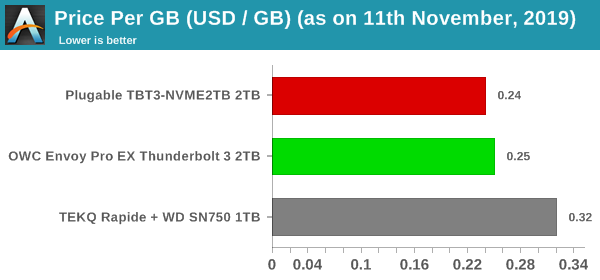
| External Flash Storage Devices - Pricing | ||||
| Product | Model Number | Capacity (GB) | Street Price (USD) | Price per GB (USD/GB) |
| Plugable TBT3-NVME2TB 2TB | TBT3-NVME2TB | 2048 | $500 | 0.24 |
| OWC Envoy Pro EX Thunderbolt 3 2TB | OWCTB3ENVP20 | 1920 | $480 | 0.25 |
| DIY TEKQ Rapide - WD Black SN750 TB3 SSD 1TB (Win 10 1809) | N/A | 1000 | $189 + $208 - $80 = $317 | 0.32 |
In summary, we would have liked better performance consistency for stressful writes from both the Plugable TBT3-NVME2TB and the OWC Envoy Pro EX Thunderbolt 3. However, given the price points, very few users may complain about that aspect. The thermal design for the Plugable drive is excellent, while the ruggedness of the OWC drive may make it attractive to certain market segments. By and large, the performance of the Plugable and OWC drives are equivalent, and users can make a purchase decision purely based on the best available deal at the time of purchase. On a general note, we are happy to see the appearance of economical Thunderbolt 3 SSDs in the market with high performance for real-world workloads.

